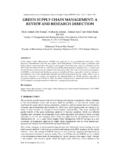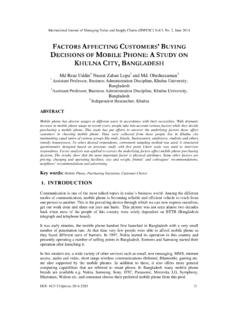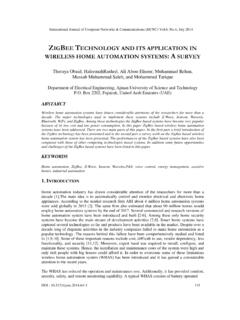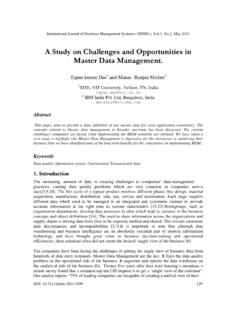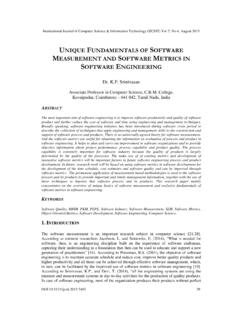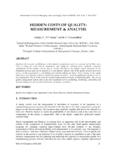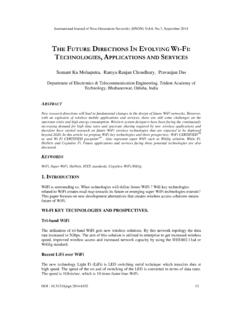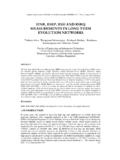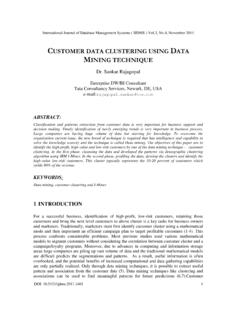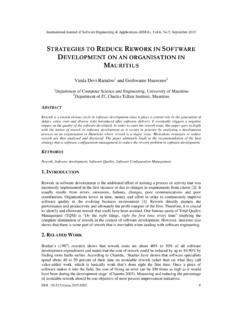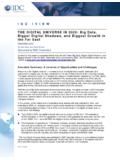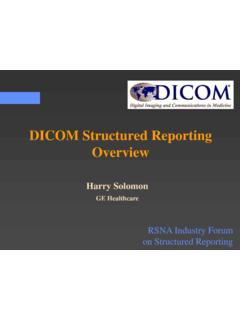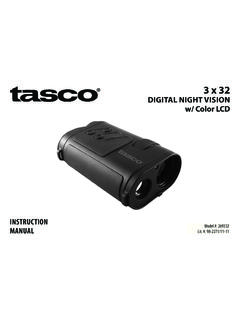Transcription of ON THE IMAGE QUALITY AND ENCODING TIMES OF LSB, …
1 International Journal of Computer Science & Information Technology (IJCSIT) Vol 7, No 4, August 2015. ON THE IMAGE QUALITY AND ENCODING TIMES . OF LSB, MSB AND COMBINED LSB-MSB. STEGANOGRAPHY ALGORITHMS USING DIGITAL. IMAGES. Solomon and Adebanke Department of Computer Science, University of Ibadan, Nigeria ABSTRACT. The Least Significant Bit (LSB) algorithm and the Most Significant Bit (MSB) algorithm are steganography algorithms with each one having its demerits. This work therefore proposed a Hybrid approach and compared its efficiency with LSB and MSB algorithms. The Least Significant Bit (LSB) and Most Significant Bit (MSB) techniques were combined in the proposed algorithm. Two bits (the least significant bit and the most significant bit) of the cover images were replaced with a secret message.
2 Comparisons were made based on Mean-Squared Error (MSE), Peak Signal-to-Noise Ratio (PSNR) and the ENCODING time between the proposed algorithm, LSB and MSB after embedding in digital images. The combined technique produced a stego- IMAGE with minimal distortion in IMAGE QUALITY than MSB technique independent of the nature of data that was hidden. However, LSB algorithm produced the best stego- IMAGE QUALITY . Large cover images however made the combined algorithm's QUALITY better improved. The combined algorithm had lesser time of IMAGE and text ENCODING . Therefore, a trade-off exists between the ENCODING time and the QUALITY of stego- IMAGE as demonstrated in this work. KEYWORDS. Steganography, Cover IMAGE , Most Significant Bit (LSB), Least Significant Bit (LSB).
3 1. INTRODUCTION. Steganography is the art and science of hiding sensitive information in ways that prevent detection. The purpose of steganography is to convey a message in such a way that nobody apart from the sender and intended recipient suspects the existence of the message. These messages are transferred through cover carriers such as text, audio, images and protocols [1, 2]. The secret message could be a plaintext, cipher text or images. The embedding of the message into a cover object results in the production of a stego- IMAGE . Images are mostly used as cover objects in steganography. Different IMAGE Steganography technique exists which are classified into spatial domain and transform domain steganography.
4 In spatial domain scheme, the secret information is directly embedded. Its high capability of hiding and easy retrieval makes it to be used frequently. An example is the least significant bit algorithm which is key to the embedding algorithm proposed in this paper. Transform domain scheme is used for hiding a large amount of data. It hides information in frequency domain by altering magnitude of all transforms of cover IMAGE . Discrete Cosineransform (DCT), Discrete Fourier Transform, and Wavelet Transform are the main types 79. International Journal of Computer Science & Information Technology (IJCSIT) Vol 7, No 4, August 2015. of transforms used in steganography. These transforms all have coefficients associated with them.
5 The secret data is hidden within these coefficients which also defines how the IMAGE or file should be transformed [3]. Examples include JPEG Steganography and Spread Spectrum. The performance of a steganography technique can be measured using several parameters, among which are imperceptibility, robustness and capacity. Imperceptibility is defined as the ability to avoid detection, the inability to determine the existence of a hidden message. This makes it an important requirement in steganography. Robustness refers to how well a steganography technique can resist the extraction of hidden data. It measures the ability of the steganography technique to survive the attempts of removing the hidden information.
6 Such attempts include, IMAGE manipulation (like cropping or rotating), data compression and IMAGE filtering [4]. Payload Capacity represents the maximum amount of information that can be safely embedded and retrieved in a work without being statistically detectable. When compared with watermarking that requires embedding only a small amount of copyright information, Steganography requires sufficient embedding capacity [5]. The Least Significant Bit (LSB) is one of most common embedding techniques. The least significant bit is the least value in a binary number. In LSB algorithm, data is hidden in the least significant bits of the cover IMAGE wfqhhich is not noticeable when viewed with the human eye [4].
7 The most significant bit (also called the high-order bit) is the bit position in a binary number having the greatest value. The aim of this work is to compare the IMAGE QUALITY and the ENCODING TIMES of LSB, MSB and the proposed Combined-LSB-MSB Steganography algorithms using digital images. The objectives are to: Combine the LSB and MSB techniques into a Hybrid algorithm that embeds secret message bits into the least significant bit and most significant bit of the cover IMAGE . Compare the LSB, MSB and the proposed algorithms (named Combined-LSB-MSB and hence called Hybrid) in terms of ENCODING time , MSE (Mean Squared Error) and PSNR. (Peak Signal to Noise Ratio). Test the algorithms using different IMAGE formats (JPG and PNG) and the QUALITY of IMAGE with increase in file size.
8 The rest of the paper is organized as follows. Section II reviews existing IMAGE steganography methods and section III presents the proposed IMAGE embedding method. The experimental results & discussion are shown in section IV and conclusions are drawn in section V. 2. RELATED WORK. There has been several researches in hiding data inside an IMAGE using steganography technique. In Warkentin et al. [6] proposed algorithm, the idea was to hide data inside the audiovisual files. El-Emam's [7] proposed steganography algorithm is based on hiding a large amount of data file inside a coloured bitmap IMAGE . In his work, he filtered and segmented the IMAGE by using bits replacement on the appropriate pixels.
9 A concept defined by main cases with their sub cases for each byte in one pixel was used to select these pixels randomly rather than sequentially. This concept was both visual and statistical. The result of this concept was that 16 main cases with their sub cases covered all aspects of the input data into color bitmap IMAGE . Three layers provided high security which made it difficult to break through the encryption of the input data and also undectable when steganalysis is applied. it was concluded that a large amount of data that occupies 75% of the IMAGE size can be embedded efficiently and the output will be of high QUALITY . 80. International Journal of Computer Science & Information Technology (IJCSIT) Vol 7, No 4, August 2015.
10 Chen et al. [8] modified a method proposed by Chang et al. [9] using the side match method. In this method, data was hidden in the edge portions of the IMAGE . The IMAGE QUALITY was improved while maintaining the same embedding capacity because the human eyes could rarely see differences in the edge portion. The embedding capacity can also be adjusted based on the demands of individual users. In addition to the improvement on IMAGE QUALITY , the proposed approach provided respectable security as well. Wu and Tsai [10] proposed an algorithm using pixel-value differencing which partioned the original IMAGE into non-overlapping blocks of two consecutive pixels. A different value was calculated from the values of the two pixels in each block.
